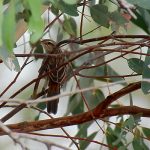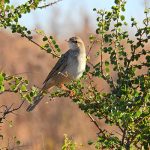RUFOUS SONGLARK
(Cincloramphus mathewsi)
Sharon: We have been lucky enough to have camped near Rofous Songlarks on several occasions, on our travels where we were able to listen to their amazing songs. They are often hard to see as they do like to hide while they are singing.
The Rufous Songlark: Voice of the Open Woodlands
Imagine the soft golden light of dawn spilling across a wide Australian grassland. Amid the hush, a rich, melodious song rises from a lone fence post. This is the call of the Rufous Songlark, one of Australia’s most gifted avian vocalists, a bird whose story is woven deeply into the tapestry of open country across the continent’s east and south.
Habitat and Distribution
The Rufous Songlark thrives where land meets sky—open woodlands, grassy plains, and farmlands dusted with scattered trees and shrubs. These environments provide a delicate balance:
- Open ground for foraging
- Shrubs and low branches for safe nesting and singing
You’re most likely to encounter them in the eastern and southern regions of Australia, though their range can shift with the seasons. In cooler months, some birds migrate northwards, returning south to breed as the weather warms.
| Region | Seasonal Presence |
|---|---|
| Southern | Breeding (Aug-Jan) |
| Northern | Winter refuge (cooler months) |
Appearance and Sexual Dimorphism
A closer look reveals striking differences between the sexes:
- Males: Larger, with vivid rufous-brown plumage that glows in the sunlight, especially on the back and wings
- Females: More modest in size and colour, with softer, earth-toned feathers that blend into their environment
This subtle beauty allows them both to thrive—males attracting mates, females remaining well-camouflaged while nesting.
Breeding and Nesting
The breeding season unfolds from August to January, filling the air with song. Males are tireless performers, their voices echoing from treetops and fence posts, a complex web of notes designed to charm and challenge.
Nesting Rituals
- Nest Construction: Females weave cup-shaped nests from grasses and fine plant fibres, tucking them low in dense vegetation for protection.
- Eggs: 2 to 4 per clutch, creamy and speckled, hidden from view.
- Incubation: About two weeks, with both parents devotedly sharing the duties of feeding and guarding their chicks.
The nest’s placement—often low and hidden—offers shelter from predators, while the parents’ vigilance gives their young the best chance of survival.
Song and Behaviour
Few Australian birds match the Rufous Songlark for sheer vocal prowess. Their songs are:
- Complex: Layered with trills, whistles, and melodic phrases
- Powerful: Carrying across fields, especially at dawn and dusk
- Purposeful: Used to define territory and attract mates
Imagine the air shimmering with sound, each note a declaration of presence and vitality.
Diet and Foraging
With sharp eyes and quick movements, Rufous Songlarks search for:
- Insects and invertebrates: Grasshoppers, beetles, caterpillars
- Seeds and plant material: Supplementary food during leaner times
They forage mostly on the ground, blending patience with bursts of energy, their movements almost invisible amid the textured grasses.
Lifespan and Challenges
While exact figures are scarce, most small songbirds live 2 to 5 years in the wild. Those that survive the hazards of weather, predation, and human activity may live even longer.
Threats
- Habitat loss: Clearing and agricultural expansion reduce safe nesting and feeding grounds.
- Degradation: Weed invasion and land development disrupt the delicate balance of their homes.
Conservation and Connection
Every song sung by the Rufous Songlark is a thread in the living fabric of Australia’s wild places. Protecting their habitat not only preserves this unique bird but also the wider ecosystem that supports countless other species.
What Can We Do?
- Support habitat restoration projects
- Promote sustainable land use that balances human needs with those of wildlife
- Foster appreciation for open country and its often-overlooked inhabitants
Sensory Experience
Picture standing in a grassy paddock, the scent of dry earth and wildflowers in the air. The breeze rustles through the acacias, and, rising above it all, the clear, intricate song of the Rufous Songlark invites you into a world where every note matters.
The Rufous Songlark is more than just a bird—it is a symbol of Australia’s open landscapes and the beauty that emerges when land, life, and voice come together. By understanding and protecting these remarkable songbirds, we celebrate the diversity and wonder of the natural world.
Let their song remind us of the value of every wild place, and the shared responsibility we hold in preserving them for generations to come.


